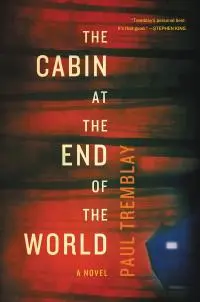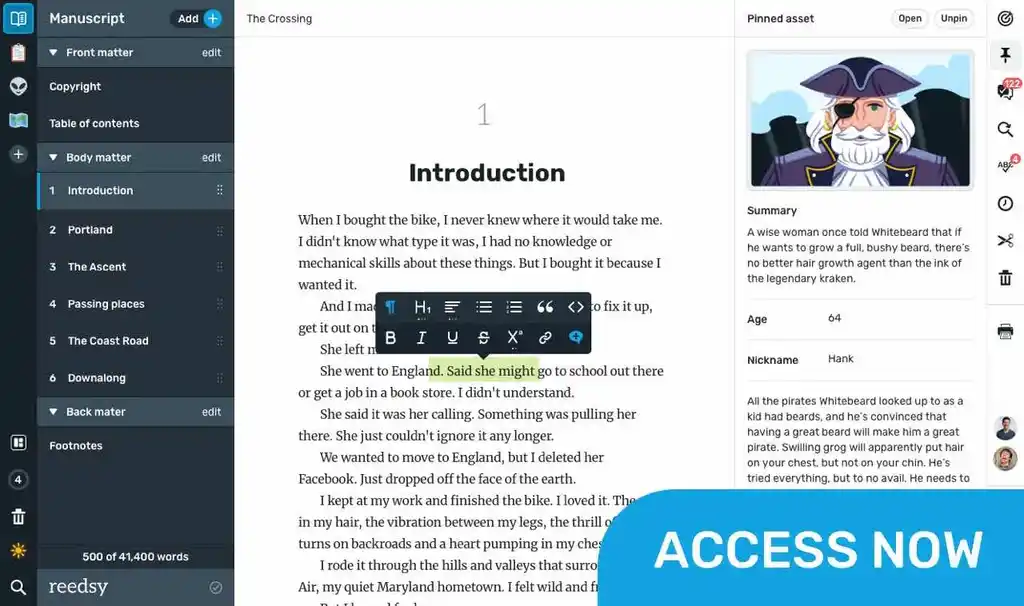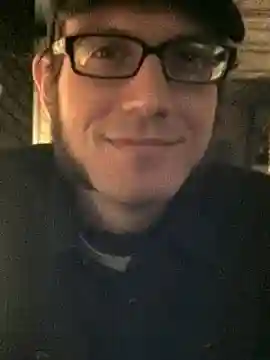What happens when a novel of unabashed and beautiful ambiguity gets in the hands of a decidedly unsubtle — at times even blunt — filmmaker? Knock at the Cabin happens, an adaptation of Paul Tremblay’s 2018 novel, The Cabin at the End of the World, written and directed by the one and only M. Night Shyamalan. The script was originally written by Steve Desmond and Michael Sherman, but was re-written (and presumably retitled) by Shyamalan.
The premise of Tremblay’s work, which won Best Novel at the 2019 Bram Stoker Awards, begins deceptively simple: A family’s vacation goes sideways when four armed people break into their lakeside cabin and unleash horror. But a typical “home invasion” this isn’t, and in turning genre tropes on their head, Tremblay unveils a devastating meditation on the slippery nature of faith, love and survival. Shyamalan winnows all this down into a tense thriller that works fine up until around the third act, when the narrative deviates from the source material and becomes decidedly, well, Shyamalan-esque.
Let’s dive in to the major differences between book and film, and pin-point all the ways the latter seems to fundamentally misunderstand what makes the former so wonderful and unique.
The Book
As previously mentioned, the story centers on Eric and Andrew and their adopted daughter Wen. They’ve left civilization for a quiet getaway in the woods, and all is well until a man named Leonard arrives. In a scene echoing James Whale’s Frankenstein, Leonard — who is as physically imposing and gentle as Boris Karloff’s take on the Monster — approaches Wen as she gathers grasshoppers in a jar (a pretty important symbol, more on that in a bit). Leonard tells Wen that he is saddened by what he has to do, just as three other people appear in the distance — another man named Redmond, and two women, Adriane and Sabrina, all of whom carry strange weapons that appear to be hastily crafted from various garden tools and other blunt objects.
Much like its title change, the film streamlines the novel's bigger ideas into taut plot lines...
The four eventually force their way into the cabin, scuffle with Eric and Andrew, then tie up the couple. Leonard reveals that his group have been wracked with visions of the apocalypse, which will begin with rising oceans followed by a plague, falling skies, and finally an unending darkness that will consume the earth. He tells them that the only way to stop this grim end is if they, as a family, choose to sacrifice one of their own. Naturally, Eric and Andrew refuse to make a such choice, believing Leonard and his gang to be religious zealots off their rockers. Because they will not make a sacrifice, the group instead ritualistically executes Redmond as a way to slow down the apocalypse, but Leonard shows the family a live news broadcast about a deadly tsunami (rising oceans) hitting the Oregon coast as proof the apocalypse is upon them, even if it’ll take a smidge longer than expected.
Andrew — arguably the protagonist of this novel — isn’t convinced. He counters that the initial earthquake that instigated the string of earthquakes that created the pummeling tsunami happened hours before the group showed up at the cabin. They aren’t trying to save the world, he argues, but rather they’re simply there to terrorize his family, and they coordinated their attack with the earthquake news because the likelihood of a tsunami — and its devastating effects — was high. Eric, concussed from the aforementioned scuffle, sides with his husband, but he’s not as certain there isn’t some biblical destruction at hand. He’s still a semi-practicing Catholic, and at the moment Redmond died from the group’s bludgeoning, Eric thought he saw “a bas-relief made of light and outlined in more jagged light, which became a head and shoulders, then a full figure in a swirl of glint and glare,” a figure that turned “inexorably to face him.”
Thus begins a push-and-pull within and between the characters that ultimately defines Tremblay’s novel: was it some kind of harbinger Eric saw — an angel perhaps — guiding him toward revelation, or was it just a concussion-induced hallucination; is there an angry deity out there casting judgement upon Creation, or is the world merely dominated by chaos; was the tsunami a signal of the end of days, or was it just another in humanity’s long line of tragedies that dominate then fade from the 24 hour news cycle? That’s the core argument Andrew makes every time Leonard shows the family more “evidence” of the apocalypse. The “plague” his group envisioned is just another outbreak of bird flu, no more extinction-level the last one, and the “falling skies,” while certainly horrific — a slew of airplanes plummeting to the ground at the same time — is likely a cyber-terrorist attack, an event all too commonplace in our modern world. None of it, in Andrew’s view, proves anything.
 Doubling down on his belief this home invasion is just that and nothing more, Andrew becomes convinced Redmond was actually a man named Jeff O’Bannon, a homophobic "redneck" who attacked Andrew in a bar years prior and went to prison for the crime. Andrew insists O’Bannon, posing as Redmond, orchestrated the entire “end of the world as we know it” scenario as an elaborate revenge plot, every bit of it pre-planned, a conviction Andrew holds all the way to the end of the novel, despite having no concrete proof (showing that even someone committed to an atheistic, or at best agnostic, view of the world still clings to a sense of order, a "reason" for the bad things that happen to good people).
Doubling down on his belief this home invasion is just that and nothing more, Andrew becomes convinced Redmond was actually a man named Jeff O’Bannon, a homophobic "redneck" who attacked Andrew in a bar years prior and went to prison for the crime. Andrew insists O’Bannon, posing as Redmond, orchestrated the entire “end of the world as we know it” scenario as an elaborate revenge plot, every bit of it pre-planned, a conviction Andrew holds all the way to the end of the novel, despite having no concrete proof (showing that even someone committed to an atheistic, or at best agnostic, view of the world still clings to a sense of order, a "reason" for the bad things that happen to good people).
Of all the terrifying things shown on television and inflicted upon the not-so-simple home invaders, the novel’s most devastating horror involves the death of Wen, who is accidentally killed while Andrew and Leonard fight over control of a gun. What makes this moment so gut-wrenching is that the girl’s demise is pointless — the key to ending the apocalypse is a willing sacrifice, not an accidental shooting death. Or rather, this aspect of Wen’s death is heartbreaking only to those who believe the apocalypse really is at hand, primarily Leonard, but Eric definitely begins to consider the possibility this impossible situation might actually be real. But by novel’s end, not even he can argue with Andrew’s logic that even if Leonard and his gang (all dead by various means that don’t need explaining here) were right — if there really is an angry god demanding an innocent sacrifice in order to spare the rest of the world — such a god isn’t worth appeasing. “Fuck them and their god,” Andrew says. “Fuck them all.” If they’re left to wander an eternally dark world, which seems to be happening in the last few paragraphs (or maybe it’s just a bad thunderstorm), then they’ll walk it together, come what may.
Oh, and the grasshoppers? Wen, terrified by Leonard's cryptic remarks and the three armed people walking her way, abandoned them in the yard in her dash to get inside the cabin. She realizes much later their plight, but she is too late — all seven that she collected perished, either from suffocation or from the sun cooking them inside the glass jar. As Tremblay notes in the “extended liner notes” of the book, it’s no coincidence there are seven grasshoppers and seven characters in the story, a possible clue that Eric and Andrew won’t make it far in the woods and the rain. Proof of the apocalypse? Maybe. Or, the sad fate of two heartbroken, injured men succumbing to the elements. The latter scenario makes sense if we consider the grasshoppers as a general metaphor for deism, with Wen representing a stand in for a god that created a world (the glass jar), but then left them to their own devices not out of cruelty but because of circumstances outside her control. In other words, there’s a god out there that set all this in motion, but they’ve been hands off since just after creation — which is actually a kind of midpoint between the two extreme systems of belief that come to a head in the book, with one side arguing there is only chaos and the devious actions of humans, and the other insisting an entity beyond human comprehension has made a conscious decision to destroy all that which it has created.
As such, it is a fitting end to The Cabin at the End of the World, because it only raises more questions rather than provides any answers.
The Film
Knock at the Cabin sticks pretty close to its source material, until it doesn’t. Much like its title change, the film streamlines the novel's bigger ideas into taut plot lines, which diminishes Tremblay’s rich character development and contemplativeness. This happens sometimes in the translation from page to screen, and the entire cast — especially Dave Bautista as Leonard — do a fine job with the material. One of the most major changes made is the survival of Wen (Kristen Cui, a real talent to watch), which isn’t terribly surprising given that killing children is still quite taboo in American cinema.
The alterations outlined so far could be forgivable and could make for a decent adaptation. But the ultimate problem with this film — and really all of Shyamalan’s work — is the filmmaker’s insistence that every question must be answered. Rather than keeping Tremblay’s ambiguity intact, Shyamalan decides that, one, Redmond was indeed Jeff O’Bannon, and two, the characters really are facing end times. Not only this, Eric asks Andrew to sacrifice him to save the world (which he also does in the novel), but instead of refusing and proclaiming, effectively, that God can go fuck himself, Andrew pulls the trigger and kills his husband. In a rather ham-fisted sequence of falling action, Andrew and Wen go to a diner and witness on television the very rapid, decidedly unsubtle “miraculous” end to all the ills previously shown to them — recovery efforts for the tsunami are going swimmingly (pun intended), there’s a very sudden vaccine for the “plague,” and no more planes are plummeting from the sky (a CGI sequence so cartoonish it elicited laughter from the theater audience where I caught the movie). Everything’s wrapped up, neat and tidy, and all Andrew had to do was murder the love of his life and the second father of his child. But it’s okay, because he and Wen listen to Eric’s favorite song, “Boogie Shoes” by KC and the Sunshine Band, which just happens to be (miraculously) loaded up and ready to play in Redmond/O’Bannon’s truck (an apparent unrepentant redneck homophobe likes disco!).
No questioning here, no pondering on the nature of faith. There is an angry god that must be appeased through sacrifice. Not only does this undermine the very crux of Tremblay’s novel, but affirming rather than rejecting the cruelty and unfairness of an all-(too) powerful deity feels oppressive, archaic, and frankly boring.
Oh, and the grasshoppers? There’s some cool close-up shots of them here and there for the first 40 or so minutes of the film, but then they’re pretty much forgotten about.
Get Cabin at the End of the World at Bookshop or Amazon

Write your scary story in Studio
Reedsy's free writing app lets you set writing goals and track your progress, so you can — finally — write that book!

About the author
Christopher Shultz writes plays and fiction. His works have appeared at The Inkwell Theatre's Playwrights' Night, and in Pseudopod, Unnerving Magazine, Apex Magazine, freeze frame flash fiction and Grievous Angel, among other places. He has also contributed columns on books and film at LitReactor, The Cinematropolis, and Tor.com. Christopher currently lives in Oklahoma City. More info at christophershultz.com








